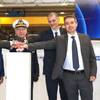Astilleros Españoles Sestao and Juliana yards have delivered the first two vessels of an inventive series of six stainless steel product/chemical carriers, Stolt Sea and Stolt Sun, both of which have joined the fleet of Stolt Parcel Tankers — the world's largest operator of its kind.
One of the most outstanding features of the series of ships is their capability of simultaneously carrying a wide variety of cargoes. Made possible by an extremely compartmentalized cargo arrangement, the vessels can carry up to 700 different types of cargoes — from fruit juice to propylene oxide — without risk of polluting each other.
This flexible cargo section is divided into 36 integral tanks and four deck tanks, designed to carry IMO type 1 and 2 chemicals, plus hazardous and corrosive cargoes by means of two longitudinal bulkheads vertically corrugated. An exception to this would lie in cargo tanks numbered one, two and 13, where the longitudinal bulkhead is arranged in the centerline.
Cargo tank capacity amounts to 25,220 cu. m. with payload cargo reaching a 24,720 cu. m. total at 98 percent cargo tank capacity.
Each tank is served by its own submerged hydraulically driven cargo pump and associated piping made of 316L stainless steel. A fully integrated cargo service system controls and monitors every operation and includes, in each cargo tank, temperature sensors at three levels, an internal cone antenna for level indication, transmitter gauges, remote pressure sensor of vapor space and independent high level (95 percent), and overfill (98 percent) alarms. This system is topped off with individual independent heating and cooling systems. Additionally, each cargo tank is fitted with three, two or one multi-stage fixed tank cleaning machine. Fully equipped with an integrated navigation bridge, fulfilling the one man bridge notation, the vessels also feature a set of systems that include one voyage data recorder system and one rate of turn indicator (ROTI) system with three repeaters. The bridge system integrates a variety of functions such as digital radars, adaptive track pilot and position sensors.
Able to apply a service speed of 15.2 knots, the vessels' structure includes a double skin design and double bottom running the entire length of the cargo section plus the engine room. The double sides protect the cargo area by way of longitudinal flat bulkheads.
Subscribe for
Maritime Reporter E-News
Maritime Reporter E-News is the maritime industry's largest circulation and most authoritative ENews Service, delivered to your Email five times per week












